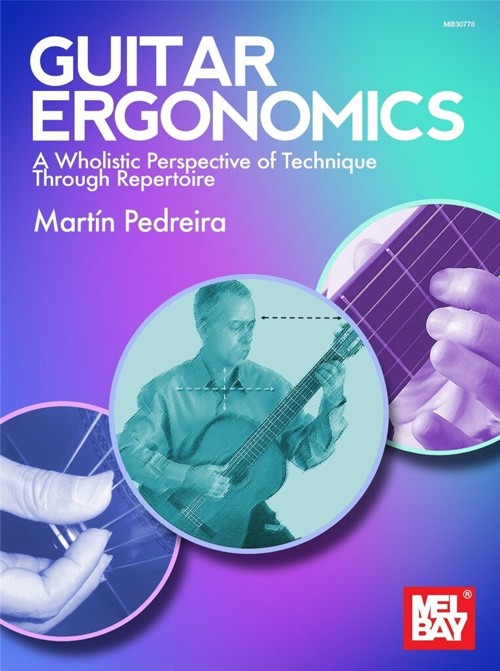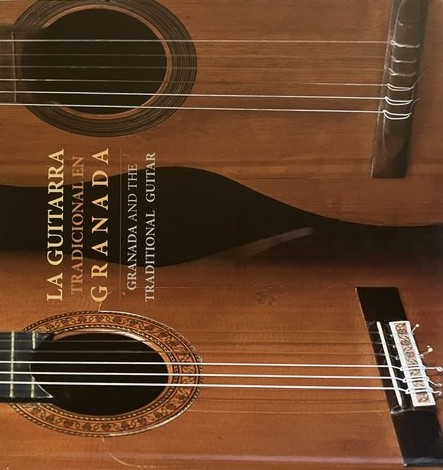
Guitar Ergonomics. A Wholistic Perspective of Technique Through Repertoire
Pedreira, Martín
Mel Bay Pub., Inc.. 2021Ficha técnica
- EAN: 9781513465623
- ISBN: 978-1-5134-6562-3
- Editorial: Mel Bay Pub., Inc.
- Fecha de edición: 2021
- Encuadernación: Rústica
- Dimensiones: 22,5x29,5
- Idioma: Inglés
- Nº páginas: 136
No disponible temporalmente
Disponibilidad sujeta a la información del editorPVP. 32,20€
Añadir a la Lista de deseos
As the title of his book attests, guitarist and musicologist Mart n Pedreira presents a methodical treatment addressing the most highly refined guitar techniques. In my opinion, we should not confuse the methodical with the routine, because the latter does not facilitate the completion of any task. We applaud Pedreira for his rigorous vision of instrumental practice and his meticulous attention to the physical-motor aspects of the instrumentalist. This reference book is worthy of frequent consultation for its valuable suggestions. Leo Brouwer This comprehensive reference book integrates the historical, structural, technical, and ergonomic aspects of classic guitarperformance with the individual player?s cultural, intellectual, creative, and emotional facets in what the author calls a psychophysiological approach to interpretation. In addition to its emphasis on ergonomic posture and technique, the book includes over 200 short musical excerpts by Sor, Giuliani, Coste, Tárrega, Barrios, Montoya, Ponce, Pujol, Villa-Lobos, Rodrigo, Brouwer and others? illustrating practically every aspect of classic and flamenco guitar technique. This unique Wholistic Perspective of Technique Through Repertoire will be useful to teachers, aspiring composers, and to students and professionals forming recital and concert programs. Given the author?s extensive survey of technique and repertoire from an ergonomic point of view, it is likely that even seasoned concert artists and teachers will find something new of intense interest to share with their audiences and students. No classic guitarist?s library would be complete without this landmark book! The author?s goal in presenting this multifaceted approach is to provide theoretical and practical coordinates for improving guitar interpretation while acknowledging the player?s intellectual and emotional contributions. While there is no companion recording for this book, many of its examples can be heard in their entirety on YouTube. The inclusion of numerous quotes from renowned guitar virtuosos and other instrumentalists, plus statements by non-musician artists, scientists, and psychophysical experts from the Renaissance to the present day ? emphasize the wholistic nature of this book. Readers
CONTENIDO:
1. Posture, Instrument Placement and Breathing
2. Normal Posture and Mobility
3. Traditional Placement of the Guitar
4. Psychophysical Effects
5. Slanted Placement
6. Tilting of the Soundbox
7. Other Issues Related to Posture with the Instrument
8. Remodeling Instrument Placement
9. Breathing
10. Abdominal Breathing
11. Breathing Rhythm
12. Breathing versus Excitement
13. THE RIGHT HAND
14. The Postural Frame
15. Forearm Support Point
16. Hand-Forearm Placements
17. Aligned Placement
18. Intermediate Placement
19. Curved Placement
20. Alignment of the Fingers and Roundness of the Hand
21. Sensopostural Patterns
22. Physical-Acoustic Phenomena and Tone in Performance
23. Learning the Sound of the Instrument
24. The Plucking Mechanism
25. The Plucking Cycle
26. Contact with the Strins
27. Fingernail Attack
28. Fingertip/Nail Attack
29. Fingertip Attack (Thumb)
30. ÿPlanting: Coordination and Synchrony for a Balanced Mobility
31. Simultaneous Planting
32. Sequential Planting
33. Grip/Thrust
34. Free and Rest Strokes
35. Fixation (Muscular Integration in Plucking)
36. Exit and Relax
37. Physiological aspects that contribute to relaxation in both hands
38. Sensoperceptive Exercises for the Right Hand
39. Stimulating the Perception of Contact
40. Perception of Grip
41. ?Silent Plucking? (Simultaneity with the Thumb)
42. Rapid Repositioning
43. ?Tick Tock: (Fingernail Attack)
44. Release from the Bottom
45. Perception of Thrust (rest Stroke)
46. Exploring and Activating Relaxation
47. Tonicity Patterns (Flexibility of Muscle Tones)
48. Better Perception, Fewer Repetitions
49. Use of Voluntary Fixation in Plucking
50. Fixation with i-m-a
51. Fixation with the thumb
52. Applications
53. Fingering: Functional
54. Regularities and Options
55. Finger Crossing
56. The Little Finger
58. Artificial Harmonics
59. Five-Note Chords
60. ARPEGGIOS
61. More About the Thumb
62. Timbre
63. Twin-stroke
64. Support-Planting
65. Displacements
66. Control of Resonance by Damping
67. Right-Hand Articulation Techniques
68. Legato And Staccato
69. Rest/Free Alternation
70. ?Vertical Articulation?
71. INTERVALS
72. Arpeggiated Chords
73. Dynamic Enhancement (Highlighting Notes)
74. Strumming (Rasgueado)
75. Preparatory Exercises
76. Functional Relaxion in Strumming
77. THE LEFT HAND
79. Hand Roundness
80. Hand-Forearm Alignment/Control of the Arm Angles
81. Hand Rotation/Control of Supination
82. Left-Hand Sensopostural Pattern
83. The Placement-Release Cycle
84. Contact with the Strings
85. Balance of Positioning
86. Thumb Placement
87. Palm View
88. Side View
89. Thumb Position Readjustments
90. Placement of Finger
91. Planting in Linear Passages
92. Finger Pressure (Pisado)
93. Weight and Flotation
94. Release (Relax) and Exit
95. Position Shifts
96. Types of Position Shifts
97. Movement Transmission in Longitudinal Shifts
99. Hand Presentation on the Fretboard and Transverse Shifts
100. Perceptual Guidelines for Mobility in Shifting
101. Perception of Effort
102. Visual Orientation
103. Reference Points on the Fretboard
104. Visualization Strategies
105. Practice of Shifts by Leap
106. Reducing Noise in Shifting
107. Other Means for Precision and Economy of Effort in Shifting
108. Mechanics of Support Point
109. Pivot Finger
110. Avoiding Successive shifts in Opposite Directions
111. Using Less Supination in Linear Passages
112. Progressive Placement and Release of Chord Positions
113. Barre
114. Roundness of the Hand in Barre
115. Using Selective Pressure in Barre Chords
116. Reshaping the Barre
117. Increased Economy of Effort
118. Using the Weight of the Arm
119. Intermittent Release of Pressure
120. Selective Pressure in Linear Passages
121. Barre in Advance
122. Partial Barre
123. Hinge Barre
124. ?Fourth-Finer Barre?
125. Extensions
126. Preparing Extensions
127. Alternatives
128. Left-Hand Articulation Techniques
129. Legato by Sustaining Resonance
130. Campanella
131. Direct use of Sympathetic Resonance
132. Slurs (Ligados)
133. Planting when Playing Slurs
134. Cross-String Slurs
135. Rotation of the Hand in Slurs
136. Staccato
137. Slur-Staccato
138. Glissando
139. Fast Glissandi : From a note without fixed duration to another note with Fixed duration --- Between two notes with fixed duration ---Portamento
140. Short Portamento
141. Practice of Short Portamento
142. ÿVibrato
143. Prolonging the Sound
144. EPILOGUE
145. Appendixes
146. A Brief Anatomical and Physiological Outline
147. Study of Symmetries of Body Posture Using Profilometry
148. Pre-Warmup Exercises






